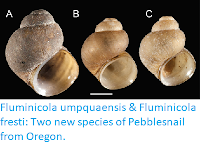The Monoplacophorans are a poorly understood group of Molluscs superficially resembling Limpets, but quite distinct from the Gastropods. Like Gastropods they have a muscular foot, a shell and a scraping radula (tongue), but unlike them they lack eyes (or much of a head at all) have gills on each side of their body, which form a series of pairs, and their shell is attached to their body by eight pairs of dorso-ventral muscles. Monoplacophorans are known in the fossil record from the Cambrian to the Devonian, and for a long time were thought to be extinct, till a live specimen was recovered from the deep sea in 1952. Since more than 35 species of Monoplacophorans have been described, all from the deep oceans, although only two species have been encountered more than once, and almost nothing is known about their habitat or ecology.
In a paper published in the journal Marine Biodiversity on 7 March 2018, Julia Sigwart of the Marine Laboratory at Queen’s University Belfast, and the Museum of Paleontology at the University of California, Berkeley, Mary Wicksten of the Department of Biology at Texas A&M University, Matthew Jackson of the Department of Earth Science at the University of California Santa Barbara, and Santiago Herrera of the Department of Biological Sciences at Lehigh University, report the first direct observations of what appears to be a new species of Monoplaophoran from seamounts in American Samoa.
Sigwart et al. report that non-periodic, sinusoidal trails clear of sediment were observed on ferromanganese-encrusted lava flows were observed at a depth of 3760 m on the Leoto Seamount and 3837 m on the Utu Seamount on the Manahiki Plateau while they were being explored by the remotely operated vehicle (ROV) Deep Discoverer and the camera platform Seirios, operated from the NOAA Ship Okeanos Explorer, during an expedition to the area between February and April 2007. Further examination of these trails revealed a Monoplacophoran trail-maker on the Utu Seamount.
Sigwart et al. report that non-periodic, sinusoidal trails clear of sediment were observed on ferromanganese-encrusted lava flows were observed at a depth of 3760 m on the Leoto Seamount and 3837 m on the Utu Seamount on the Manahiki Plateau while they were being explored by the remotely operated vehicle (ROV) Deep Discoverer and the camera platform Seirios, operated from the NOAA Ship Okeanos Explorer, during an expedition to the area between February and April 2007. Further examination of these trails revealed a Monoplacophoran trail-maker on the Utu Seamount.
Trackways attributed to Neopilina sp. in still images from HD video. (a) Overview of rock surface marked with feeding trails at Leoso Seamount (where no animals were observed). (b) Trackways at Utu Seamount; red dots are laser sights 10 cm apart. (c) Neopilina sp., at Utu seamount, close-up showing apparent radular scratches within trackway. Original video data from the NOAA Office of Ocean Exploration and Research. Sigwart et al. (2018).
The trail-maker is thought to be a member of the genus Neopilina, and measures about 20 mm in length and about 12 mm in width, exceptionally large for a modern Monoplacophoran, even a member of the large-bodied genera Adenopilina, Vema, and Neopilina (prior to this only six modern specimens larger than 10 mm in length had been observed, all from depths of greater than 3000 m. However, the observed specimens differ from other previously described members of the genus in several ways, most notably the presence of longer, more slender gills. This is unsurprising, as the nearest previous sighting of a member of the genus was from Hawaii, 4000 km away, and leads Sigwart et al to conclude that this is a new species, though they stop short of describing it as such, due to the absence of any recovered material. In living on ferromanganese-encrusted lava flows, this Monoplacophoran inhabits an ecological niche where the group has not previously been observed, though other species have been recovered from ferromanganese nodules dredged from the seafloor (most known modern Monoplacophorans have been lifted from the seafloor on some sort of object). As such if opens the possibility that Monoplacophorans are much more abundant than previously realised, as seamounts and lava flows cover much of the deep ocean floor.
See also...
See also...
Follow Sciency Thoughts on Facebook.







